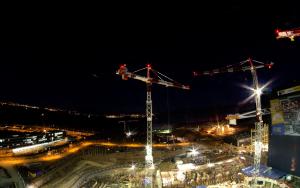A streak of light in the winter sky
A streak of light in the winter sky—not a shooting star, not a jetliner condensation trail glowing in the dark but ... the International Space Station (ISS) flying high over the ITER worksite.
In one single image, the two largest international scientific collaborations ever established are captured: on the ground, the seven-Member, 35-nation ITER collaboration; and 400 kilometres overhead a project bringing together the American, Russian, Japanese, European and Canadian space agencies.


